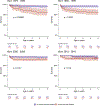Narrowing the Survival Gap: Trends in Survival of Individuals with Down Syndrome with and without Congenital Heart Defects Born 1979 to 2018
- PMID: 37244582
- PMCID: PMC10538432
- DOI: 10.1016/j.jpeds.2023.113523
Narrowing the Survival Gap: Trends in Survival of Individuals with Down Syndrome with and without Congenital Heart Defects Born 1979 to 2018
Abstract
Objective: To evaluate the hypothesis that childhood survival for individuals with Down syndrome (DS) and congenital heart defects (CHDs) has improved in recent years, approaching the survival of those with DS without CHDs.
Study design: Individuals with DS born from 1979 to 2018 were identified through the Metropolitan Atlanta Congenital Defects Program, a population-based birth defects surveillance system administered by the Centers for Disease Control and Prevention. Survival analysis was performed to evaluate predictors of mortality for those with DS.
Results: The cohort included 1671 individuals with DS; 764 had associated CHDs. The 5-year survival in those with DS with CHD improved steadily among individuals born in the 1980s through the 2010s (from 85% to 93%; P = .01), but remained stable (96% to 95%; P = .97) in those with DS without CHDs. The presence of a CHD was not associated with mortality through 5 years of age for those born 2010 or later (hazard ratio, 2.63; 95% CI, 0.95-8.37). In multivariable analyses, atrioventricular septal defects were associated with early (<1 year) and late (>5 year) mortality, whereas ventricular septal defects were associated with intermediate (1-5 years) mortality and atrial septal defects with late mortality, when adjusting for other risk factors.
Conclusions: The gap in 5-year survival between children with DS with and without CHDs has improved over the last 4 decades. Survival after 5 years remains lower for those with CHDs, although longer follow-up is needed to determine if this difference lessens for those born in the more recent years.
Copyright © 2023 Elsevier Inc. All rights reserved.
Conflict of interest statement
Declaration of Competing Interest This study was supported in part by the National Heart, Lung, and Blood Institute through the Pediatric Heart Network INCLUDE Scholars Program. The authors declare no conflicts of interest.
Figures


Similar articles
-
Maternal risk factors for congenital heart defects in infants with Down syndrome from Western Mexico.Am J Med Genet A. 2019 Sep;179(9):1857-1865. doi: 10.1002/ajmg.a.61300. Epub 2019 Jul 19. Am J Med Genet A. 2019. PMID: 31321895
-
Down syndrome and associated atrioventricular septal defects in a nationwide Norwegian cohort: Prevalence, time trends, and outcomes.Acta Obstet Gynecol Scand. 2024 Oct;103(10):2024-2030. doi: 10.1111/aogs.14932. Epub 2024 Aug 5. Acta Obstet Gynecol Scand. 2024. PMID: 39104126 Free PMC article.
-
Sex differences for major congenital heart defects in Down Syndrome: A population based study.Eur J Med Genet. 2018 Sep;61(9):546-550. doi: 10.1016/j.ejmg.2018.05.013. Epub 2018 May 9. Eur J Med Genet. 2018. PMID: 29753092
-
Prevalence of congenital septal defects among congenital heart defect patients in East Africa: A systematic review and meta-analysis.PLoS One. 2021 Apr 22;16(4):e0250006. doi: 10.1371/journal.pone.0250006. eCollection 2021. PLoS One. 2021. PMID: 33886628 Free PMC article.
-
Long-term survival of children born with congenital anomalies: A systematic review and meta-analysis of population-based studies.PLoS Med. 2020 Sep 28;17(9):e1003356. doi: 10.1371/journal.pmed.1003356. eCollection 2020 Sep. PLoS Med. 2020. PMID: 32986711 Free PMC article.
Cited by
-
Trisomy 21 and Congenital Heart Disease: Impact on Health and Functional Outcomes From Birth Through Adolescence: A Scientific Statement From the American Heart Association.J Am Heart Assoc. 2024 Oct;13(19):e036214. doi: 10.1161/JAHA.124.036214. Epub 2024 Sep 12. J Am Heart Assoc. 2024. PMID: 39263820 Free PMC article. Review.
-
Down Syndrome: Evaluating Disparities in Place of Death in the United States Using Centers for Disease Control and Prevention's Wide-Ranging Online Data for Epidemiologic Research (CDC-WONDER) Database Over 22 Years.Cureus. 2024 Jun 26;16(6):e63212. doi: 10.7759/cureus.63212. eCollection 2024 Jun. Cureus. 2024. PMID: 39070429 Free PMC article.
References
-
- Parker SE, Mai CT, Canfield MA, Rickard R, Wang Y, Meyer RE, et al. Updated National Birth Prevalence estimates for selected birth defects in the United States, 2004–2006. Birth Defects Res A Clin Mol Teratol. 2010;88:1008–16. - PubMed
-
- Körten MA, Helm PC, Abdul-Khaliq H, Baumgartner H, Kececioglu D, Schlensak C, et al. Eisenmenger syndrome and long-term survival in patients with Down syndrome and congenital heart disease. Heart. 2016;102:1552–7. - PubMed
-
- Pfitzer C, Helm PC, Rosenthal LM, Berger F, Bauer UMM, Schmitt KR. Dynamics in prevalence of Down syndrome in children with congenital heart disease. Eur J Pediatr. 2018;177:107–15. - PubMed
-
- Glasson EJ, Jacques A, Wong K, Bourke J, Leonard H. Improved Survival in Down Syndrome over the Last 60 Years and the Impact of Perinatal Factors in Recent Decades. J Pediatr. 2016;169:214–20 e1. - PubMed
Publication types
MeSH terms
Grants and funding
LinkOut - more resources
Full Text Sources
Medical
Miscellaneous

